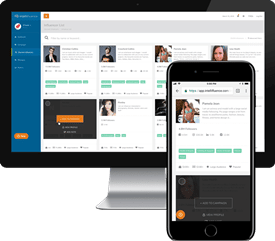Last Updated on June 8, 2020
By now in this series you have a good idea of what your goal is, you know who are ultimately trying to influence, have picked the social channels you’re going to start with, and at this point have a list of which product reviewing influencers you want to work with. The difference between knowing what you want to accomplish and actually succeeding is the next gap: you need to outreach. You need to pitch.
Cold vs Warm Outreach
I’ve been in sales positions for much of my life, and a CEO is always selling. Thus, when I have the option between cold outreach and warm outreach, the comparison isn’t even close; my success ratio is going to be exponentially better on the warm leads. As an example, if you built your contact list using a tool like Buzzstream, you have been building a cold outreach lead list and will need to take a slightly different campaign approach than if you’re reaching out to individuals that are already in the mindset of wanting to do product reviews as an influencer.
To keep this topic relatively concise, I’ll oversimplify: when performing cold outreach, the importance of the subject title and obvious value exchange are going to be even higher than if you are reaching out to a warm lead. Additionally, one needs to adopt an expectation that more than one outreach will be required. In complex sales cycles to cold leads, it was not uncommon for me to send 6+ emails over several months just trying to get the attention of a prospect and providing unique value in each email. It was also not uncommon for a sale to occur on the first pitch to a warm lead. The difference is that significant.
What Constitutes a Good Pitch?
Operating now on the assumption that you’ve signed up on a service like Intellifluence where influencers have joined the network (i.e. potential warm leads), let’s focus on what makes for a good pitch.
Converting copy — you have only one chance to make that first impression; don’t squander it with a boring subject line like “please review my product” and seventeen paragraphs on why the influencer should be falling over themselves trying to get a free sample. It doesn’t work, and the psychology is backwards. In your message body you need to play to the ego of the influencer, explain why THEY are perfect for the product, and overcome objections by stating upfront what you’re willing to offer in exchange for their time. As for titles, incredible copywriters like Joel K can teach you books worth about the hook and the reel, but suffice it to say you need that colorful lure in the subject that should probably be unique for each campaign at worst and unique for each influencer at best. Example? If you were reaching out to my influencer profile for the purposes of having me review kitten socks, be absurd: “want to increase your deadlift? Review my knee high kitten socks.” And oh yes, it happened. If the hook is really good, you can almost get away with a weaker value exchange, but since you are trying to maximize the sheer number of quality reviews in order to increase sales, we can’t overlook it.

Value exchange — in your initial outreach copy, you need to be explicit, and if you know you’re trying to get a busy influencer to work with you instead of spending their time reviewing someone else’s product, you need to stand out. Yes, the majority of the influencers in our network are willing to review in exchange for product, but the bigger the audience and more sophisticated and in-depth the review, the more willing you need to be to value that person’s time and thus, offer more value. This can come in the way of cold hard cash; it can come by promising to highlight that review for a guaranteed level of additional exposure; it can be done by offering a larger lot of product; it can be done in the red paperclip method by exchanging something the influencer wants as a means of leveling up to the influence you need. Whatever that value exchange is, don’t be stingy — if you know you’re reaching out to someone that reviews beauty products for a living and has been known to drive traffic, you’re setting yourself up for failure by trying to lowball with a small amount of product, no cash, and less value than the influencer might be getting elsewhere. Determining the right mix of value of offer can be tricky, which is why we test.
Test, Test, Test
The reality is you might find yourself in a situation where no one responds to you on some pitches and everyone responds to you on other pitches; the former is of course undesirable, but in some cases the latter should be tweaked to optimize your overall spend. Let’s talk about when and how to change up your pitches using a bit of logic.
IF no responses to your pitch THEN first change your subject to be catchier.
ELSE IF you have already modified your subject, then you need to drastically change your message to focus more on the influencer and increase the value exchange. Remember: don’t ask the influencer to jump through a lot of hoops, contact you outside of the system, or otherwise make life difficult. The simpler and more straightforward the task, with obvious value exchange, the higher probability of success.
IF responses to your pitch but no acceptances THEN improve the value exchange. In this scenario, you’re at least getting the attention of influencers, but need to compel them to want to work with you.
ELSE IF you have already increased value THEN reconsider who you are pitching to; go back to make sure you’re targeting the right type of influencer and have picked the right target list for that type.
ELSE IF you have increased value and ensured you’re contacting the right people THEN ease up on the requirements of your pitch; it is possible you are simply asking for too much and the influencers perceive it as to much of a headache.
IF you have 100% acceptance THEN consider lowering what you’re offering for the next round. I don’t intend to mean that you should be stingy, but it is possible that you may be offering too much and can afford to lower the amount of product and/or other value offered and still get an overwhelmingly positive response.
ELSE IF you have 100% and can’t lower value offered any further THEN ask for more in the way of reviews; it could be an additional post, a follow-up interview with the reviewer for your blog, etc.
IF you have a 50%+ higher acceptance rate AND you’re only offering product THEN play with changing subject and messaging on each round of outreach to see if you can increase the number of reviews you’re getting, without having to give up any more value.
As you can see, there is always room to improve and test, to help you find the balance on receiving a strong number of reviews that result in sales, without having to offer up more than is necessary to accomplish the task.
Be Responsive
As a final note, be responsive. One characteristic that makes for an excellent reviewer is to not only follow directions, but to do so in a punctual manner. The same goes for brands; as much as you are considering and deciding on which influencers to choose, they equally deliberate on which brands to work with. It can be as simple as getting back to influencers within the day that a question is asked; brands that are quick to respond to questions will earn more attention and a higher overall close rate. Similar to making this process analogous to sales, if you want an action to occur (i.e. a reviewer to accept your pitch), you need to strike when that individual is ready to take action.
Now go pitch!

Joe, CEO and Co-Founder of Intellifluence, has over 25 years of experience in SEO, leading several successful marketing companies and providing expert consultation. He is the author of The Ultimate Guide to Using Influencer Marketing, which is available as an eBook or in print.






